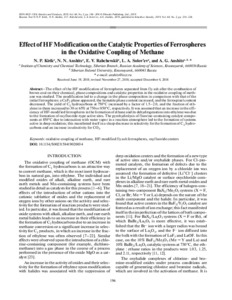Effect of HF Modification on the Catalytic Properties of Ferrospheres in the Oxidative Coupling of Methane
Скачать файл:
URI (для ссылок/цитирований):
https://link.springer.com/article/10.1134/S0020168518030032https://elib.sfu-kras.ru/handle/2311/129188
Автор:
Kirik, N. P.
Anshits, N. N.
Rabchevskii, E. V.
Solov’Ev, L. A.
Anshits, A. G.
Коллективный автор:
Политехнический институт
Кафедра химии
Дата:
2019-03Журнал:
Kinetics and CatalysisКвартиль журнала в Scopus:
Q3Квартиль журнала в Web of Science:
Q4Библиографическое описание:
Kirik, N. P. Effect of HF Modification on the Catalytic Properties of Ferrospheres in the Oxidative Coupling of Methane [Текст] / N. P. Kirik, N. N. Anshits, E. V. Rabchevskii, L. A. Solov’Ev, A. G. Anshits // Kinetics and Catalysis: Effect of HF Modification on the Catalytic Properties of Ferrospheres in the Oxidative Coupling of Methane. — 2019. — Т. 60 (№ 2). — С. 196-204Текст статьи не публикуется в открытом доступе в соответствии с политикой журнала.
Аннотация:
The effect of the HF modification of ferrospheres separated from fly ash after the combustion of brown coal on their chemical, phase compositions and catalytic properties in the oxidative coupling of methane was studied. The modification led to a change in the phase composition in comparison with that of the initial ferrospheres: a CaF2 phase appeared, the hematite phase content increased, and the ferrospinel content decreased. The yield of C2 hydrocarbons at 750°C increased by a factor of 1.5–2.0, and the fraction of ethylene in them increased to 30 or 65% at 750 or 850°C, respectively. It was assumed that an increase in the efficiency of HF-modified ferrospheres in the formation of ethane and its dehydrogenation into ethylene was due to the formation of oxyfluoride-type active sites. The pyrohydrolysis of fluorine-containing catalyst components at 850°C due to interaction with water vapor in a reaction atmosphere led to the formation of systems active in deep oxidation; this manifested itself in a sharp decrease in selectivity for the formation of C2 hydrocarbons and an increase in selectivity for CO2.

